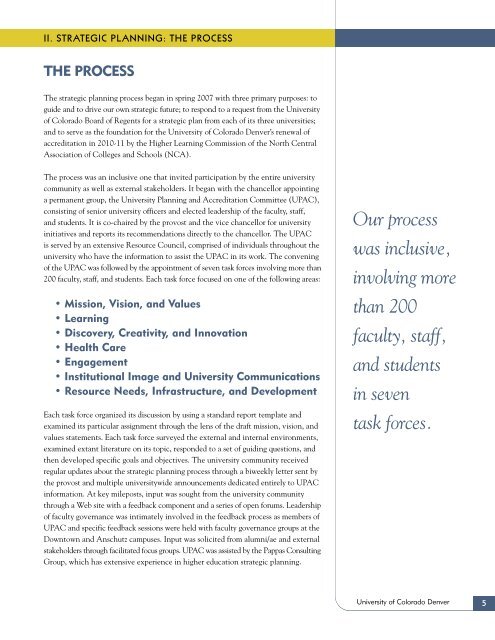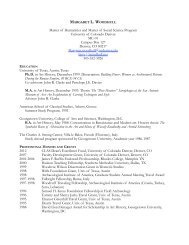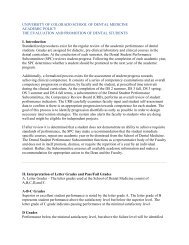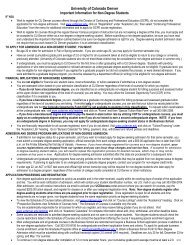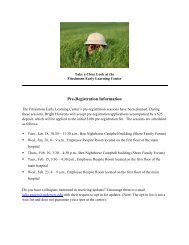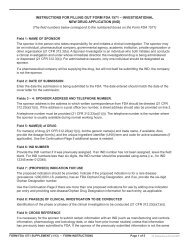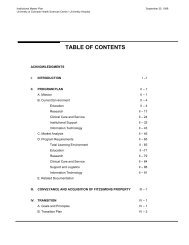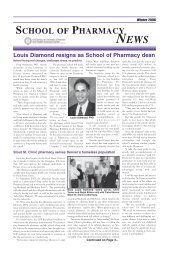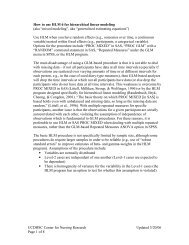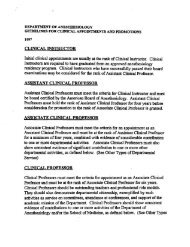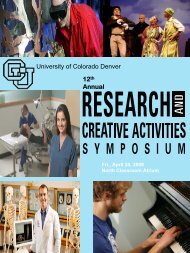Strategic Plan - University of Colorado Denver
Strategic Plan - University of Colorado Denver
Strategic Plan - University of Colorado Denver
You also want an ePaper? Increase the reach of your titles
YUMPU automatically turns print PDFs into web optimized ePapers that Google loves.
II. STRATEGIC PLANNING: THE PROCESS<br />
THE PROCESS<br />
The strategic planning process began in spring 2007 with three primary purposes: to<br />
guide and to drive our own strategic future; to respond to a request from the <strong>University</strong><br />
<strong>of</strong> <strong>Colorado</strong> Board <strong>of</strong> Regents for a strategic plan from each <strong>of</strong> its three universities;<br />
and to serve as the foundation for the <strong>University</strong> <strong>of</strong> <strong>Colorado</strong> <strong>Denver</strong>’s renewal <strong>of</strong><br />
accreditation in 2010-11 by the Higher Learning Commission <strong>of</strong> the North Central<br />
Association <strong>of</strong> Colleges and Schools (NCA).<br />
The process was an inclusive one that invited participation by the entire university<br />
community as well as external stakeholders. It began with the chancellor appointing<br />
a permanent group, the <strong>University</strong> <strong>Plan</strong>ning and Accreditation Committee (UPAC),<br />
consisting <strong>of</strong> senior university <strong>of</strong>ficers and elected leadership <strong>of</strong> the faculty, staff,<br />
and students. It is co-chaired by the provost and the vice chancellor for university<br />
initiatives and reports its recommendations directly to the chancellor. The UPAC<br />
is served by an extensive Resource Council, comprised <strong>of</strong> individuals throughout the<br />
university who have the information to assist the UPAC in its work. The convening<br />
<strong>of</strong> the UPAC was followed by the appointment <strong>of</strong> seven task forces involving more than<br />
200 faculty, staff, and students. Each task force focused on one <strong>of</strong> the following areas:<br />
• Mission, Vision, and Values<br />
• Learning<br />
• Discovery, Creativity, and Innovation<br />
• Health Care<br />
• Engagement<br />
• Institutional Image and <strong>University</strong> Communications<br />
• Resource Needs, Infrastructure, and Development<br />
Each task force organized its discussion by using a standard report template and<br />
examined its particular assignment through the lens <strong>of</strong> the draft mission, vision, and<br />
values statements. Each task force surveyed the external and internal environments,<br />
examined extant literature on its topic, responded to a set <strong>of</strong> guiding questions, and<br />
then developed specific goals and objectives. The university community received<br />
regular updates about the strategic planning process through a biweekly letter sent by<br />
the provost and multiple universitywide announcements dedicated entirely to UPAC<br />
information. At key mileposts, input was sought from the university community<br />
through a Web site with a feedback component and a series <strong>of</strong> open forums. Leadership<br />
<strong>of</strong> faculty governance was intimately involved in the feedback process as members <strong>of</strong><br />
UPAC and specific feedback sessions were held with faculty governance groups at the<br />
Downtown and Anschutz campuses. Input was solicited from alumni/ae and external<br />
stakeholders through facilitated focus groups. UPAC was assisted by the Pappas Consulting<br />
Group, which has extensive experience in higher education strategic planning.<br />
Our process<br />
was inclusive,<br />
involving more<br />
than 200<br />
faculty, staff,<br />
and students<br />
in seven<br />
task forces.<br />
<strong>University</strong> <strong>of</strong> <strong>Colorado</strong> <strong>Denver</strong><br />
75


